PM Surya Ghar Yojana
Context:
On February 29th ,The cabinet approved PM-Surya Ghar Muft Bijli Yojana for installing rooftop solar in one crore households with a total outlay of Rs.75,021 crore.1.
What is PM-Surya Ghar Muft Bijli Yojana?
PM Surya Ghar Muft Bijlee Yojana is a Central Scheme that aims to provide free electricity to one crore households in India, who opt to install roof top solar electricity units. The households will be able to get upto 300 units of electricity free every month.
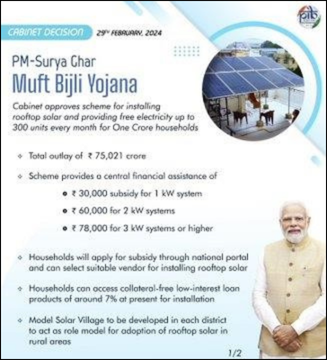
2.
What are eligibility criteria to get benefit of this scheme ?
1. The applicant must be an Indian citizen.
2. Must own a house with a roof that is suitable for installing solar panels.
3. The household must have a valid electricity connection.
4. The household must not have availed of any other subsidy for solar panels.
To apply for PM Surya Ghar Muft Bijli Yojana:
1. The interested consumer has to register on the national portal www.pmsuryaghar.gov.in . This has to be done by selecting the state and the electricity distribution company.
2. The National Portal will assist the households by providing relevant information such as appropriate system sizes, benefits calculator, vendor rating etc.
3. The consumers can choose the vendor and the make of the RoofTop Solar unit they wish to get installed
4. Households will be able to access collateral-free low-interest loan products of around 7% at present for installation of residential RTS systems up to 3 kW.
5. The interest rate has been pegged at 0.5% above the prevailing Repo Rate decided by the Reserve Bank of India from time to time.
6. In the event of the Repo Rate, which is 6.5% at present, getting reduced to say 5.5%, the effective interest rate for consumers will become 6% instead of the current 7%.
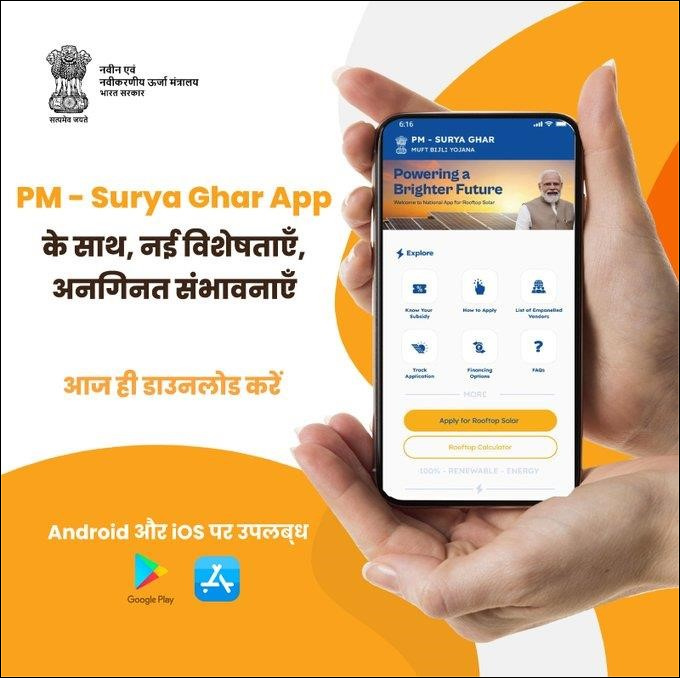
3.
Enlist some Earlier schemes started by the Government of India related to Solar energy?
Some earlier schemes related to Solar Energy are:-
1.
Jawaharlal Nehru National Solar Mission (JNNSM):
- Launched in 2010, also known as the National Solar Mission, it was a major initiative of the Government of India and State Governments to promote ecologically sustainable growth while addressing India‟s energy security challenge.
- It set an ambitious target of deploying 20,000 MW of gridconnected solar power by 2022, later updated to 100 GW in a phased manner, along with specific targets for off-grid solar power applications.
2.
Solar Park Scheme:
- Announced in 2014, this scheme aimed to facilitate the creation of large-scale solar power projects by providing developers with accessible land and infrastructure facilities.
- The scheme targeted the setup of over 20 solar parks and Ultra Mega Solar Power Projects targeting over 20,000 MW of solar power installed capacity
3.
Grid-Connected Rooftop Solar Scheme:
- This scheme encouraged the installation of solar rooftop systems to achieve a cumulative capacity of 40 GW from Rooftop Solar (RTS) Projects by the end of 2022.
- It provided subsidies for residential sectors and incentives for other sectors to install rooftop solar systems.
4.
KUSUM Scheme (Pradhan Mantri Kisan Urja Suraksha evam Utthaan Mahabhiyan):
- Launched to support the installation of off-grid solar pumps in rural areas and reduce dependence on grid power for irrigation.
- Additionally, it promotes the use of barren land for solar power generation, with a significant capacity target to contribute to the grid.
5.
Development of Solar Cities Programme:
- Aimed at reducing a minimum of 10% in projected demand of conventional energy at the end of five years, through enhanced energy efficiency and renewable energy sources.
- It designated several cities across India to be developed into „solar cities‟.
6.
Solar Rooftop Investment Program (SRIP):
- Supported by the Asian Development Bank, this program aimed to finance the installation of solar rooftop systems on residential, commercial, and industrial buildings throughout India.
4.
What is carbon footprint & how will it be reduced through PM surya ghar muft bijli yojna?
- A carbon footprint is the total amount of greenhouse gases (including carbon dioxide and methane) that are generated by our conscious actions, choices, and habits.
- The average carbon footprint for a person in the United States is 16 tons. Globally, the average carbon footprint is closer to 4 tons.
- India has emitted 15 Gt C since 1850 which is just 3 percent of the world's total. The data provided by the Global Carbon Project shows India's per capita emissions grew by 5.1 per cent in 2022 to reach 2 tonnes(just half of the world average).
- To have the best chance of avoiding a 2℃ rise in global temperatures, the average global carbon footprint per year needs to drop to under 2 tons by 2050.
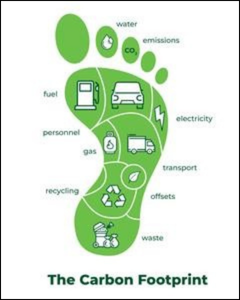
PM surya ghar muft bijli yojna will help reduce the carbon footprint by:
- Direct Reduction in CO2 Emissions: Each kilowatt-hour (kWh) of solar electricity generated can reduce greenhouse gas emissions by approximately 0.4 to 1 kg of CO2, compared to conventional fossil fuel sources. By enabling households to generate solar power, the scheme can significantly cut CO2 emissions based on the amount of solar energy produced and consumed
- Grid Stability and Lower Transmission Losses: Distributed solar energy generation can enhance grid stability and reduce transmission and distribution losses, which account for about 8-10% of total electricity generated in India. By generating electricity closer to the point of use, solar panels reduce the stress on the grid and the losses associated with long-distance electricity transmission.
- Energy Savings and Efficiency: Solar panels have a conversion efficiency of about 15-20%, and modern systems can significantly reduce electricity loss during distribution.
- Long-term Sustainability: Solar panels typically have a lifespan of 25-30 years, providing a long-term, sustainable source of energy with consistent carbon footprint reduction over time, unlike fossil fuels which have recurring emissions with every use.
- Market Transformation: Financial incentives for solar installation increase demand for solar technology, driving down costs through economies of scale. A decrease in prices accelerates adoption, further increasing the solar capacity installed and the consequent reduction in carbon emissions.
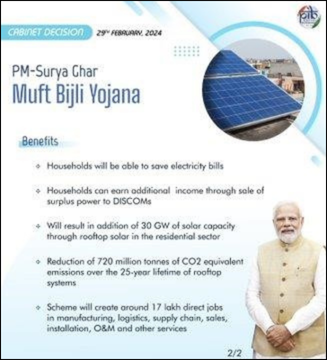
5.
What are types of solar panels? Which material is used in making solar panels?
There are 4 major types of solar panels available on the market today, these are:
| Solar Panel Type | Generation | Efficiency Rate | Advantages | Disadvantages |
|---|---|---|---|---|
| Monocrystalline Solar Panels (Mono-SI) | 1st | ~20% | High efficiency rate; optimised for commercial use; high lifetime value | Expensive |
| Polycrystalline Solar Panels (pSi) | 1st | ~15% | Cheaper | Sensitive to high temperatures; lower lifespan & slightly less space efficiency |
| Thin-Film: Amorphous Silicon Solar Panels (A-SI) | 2nd | ~7-10% | Relatively low costs; easy to produce & flexible | Shorter warranties & lifespan |
| Concentrated PV Cell (CVP) | 3rd | ~41% | Very high performance & efficiency rate | Solar tracker & cooling system needed (to reach high efficiency rate) |
What are the materials used in solar panels?
Aluminium alloy frame :
- Aluminium alloy combined with silicone beating edge to strengthen the sealing performance of the components.
- It improves the overall mechanical strength of the components.
Silicon:
- It is used to bond and seal the laminated glass PV modules, bond the junction box and backsheet, and enhance the role of UV resistance of PV modules.
Tempered glass:
- Low iron tempered glass (also known as white glass), in the wavelength range of the solar cell spectral response (320-1100 nm) transmittance of more than 93%, for infrared light greater than 1200 nm has a high reflectivity.
- The glass should be clean and free of water vapour, no bare hands touching the two surfaces of the glass.
EVA encapsulation film:
- Copolymer of ethylene and vinyl acetate, is a hot melt adhesive.
- It is used to encapsulate the cell, prevent the external environment on the electrical performance of the cell, enhance the light transmission of photovoltaic modules, the cell, tempered glass, backsheet bonding together, with a certain adhesive strength.
Photovoltaic welding tape:
- Also called tinned copper tape, mainly divided into interconnection strips and convergence strips.
- Interconnection strip is mainly used in the connection between the photovoltaic module cells, to conduct electricity and collect the role of the cell current.
Cell:
- A solar cell is a device that converts light energy directly into electrical energy. It is made of semiconductor material.
Backplane:
- It is used as a backside protective encapsulation material, the most common ones are TPX, KPX and PET, etc. It is used to enhance the aging resistance and corrosion resistance of PV modules, which prolongs the service life of PV modules.
Junction box
- Installed in the photovoltaic module to play a role in the transmission of current, with good electrical performance
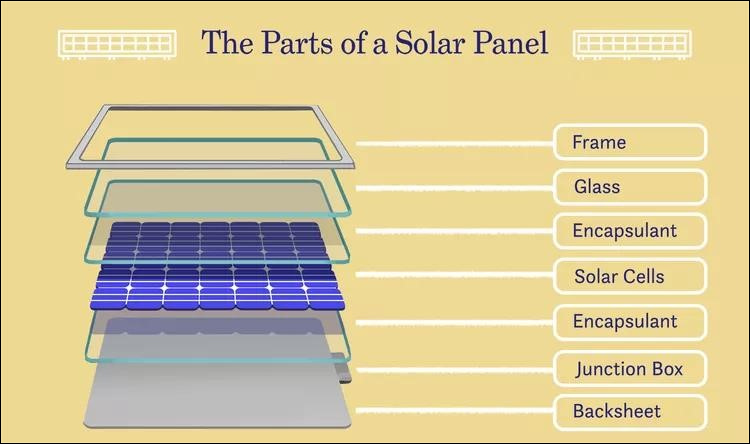
Do We Have Enough Materials To Keep Up With The Growth Of Solar?
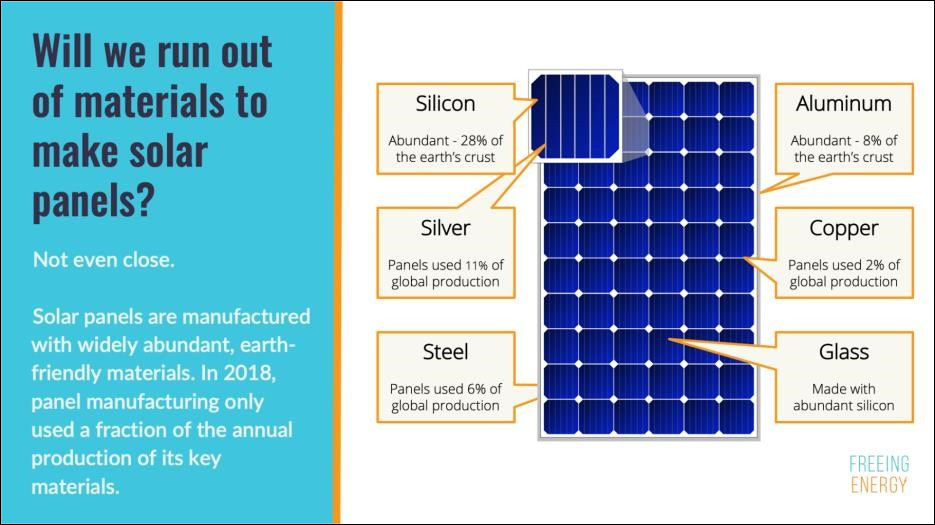
- There appear to be no major commodity material constraints for terawatt-scale PV deployment through 2050.
6.
What is the Scientific Law which is used in converting solar energy to electrical energy?
- The photovoltaic effect is the phenomenon that allows solar panels to convert sunlight into electricity. It was discovered by French physicist Edmond Becquerel in 1839 when he noticed that the electric current in a solution was enhanced when light was shined on it
- The photovoltaic effect occurs when photons and light particles strike a photoelectric surface, such as a semiconductor material.
- Semiconductors are crucial components in solar panels as they enable the photovoltaic effect to occur. (Silicon is the most commonly used semiconductor material in solar panels due to its abundance and favourable electrical properties).
- When photons strike the surface of a solar panel, they transfer their energy to the electrons in the semiconductor material, causing them to become excited.
- This excitation allows the electrons to break free from their atomic bonds and move freely through the material, creating an electric current.
- This flow of electrons is what generates electricity in a solar panel.
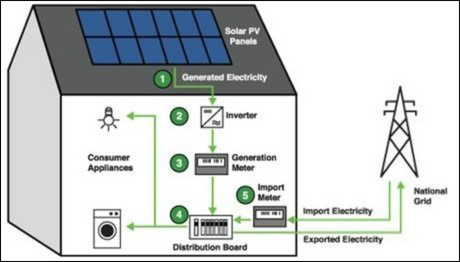
7.
Can households use energy directly generated through solar panels?
Solar panels generate DC electricity from sunlight, and this is stored in the batteries. When the stored energy is used to power a home, an inverter converts it from DC to AC, the standard for household appliances.
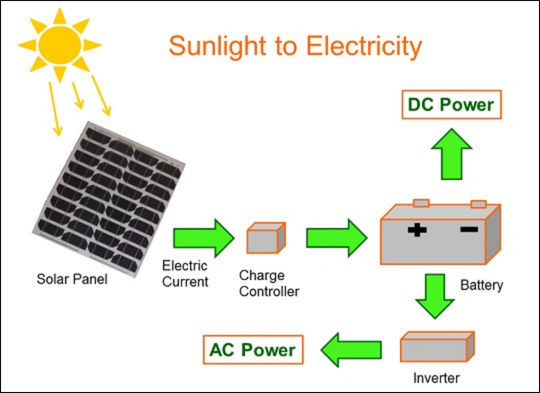
8.
What is total power generation in India at present and sector wise % contribution like how much is thermal, hydel, nuclear, renewable ( Solar, Wind, Etc) ?
India‟s total installed electricity capacity stands at 428 GW as on 31.12.2023 as told by Union Power and New & Renewable Energy Minister.
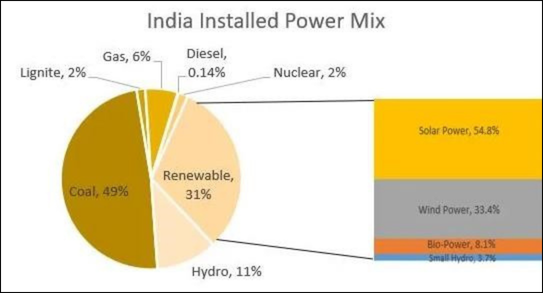
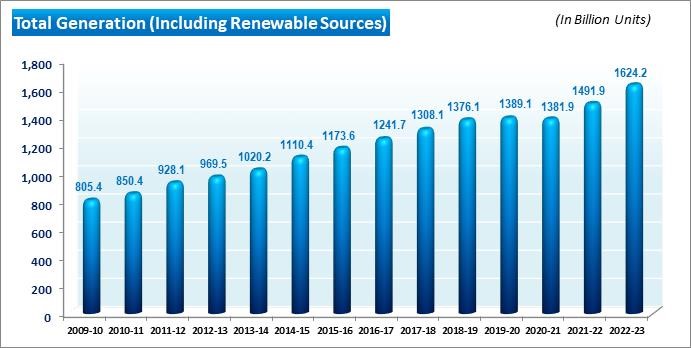
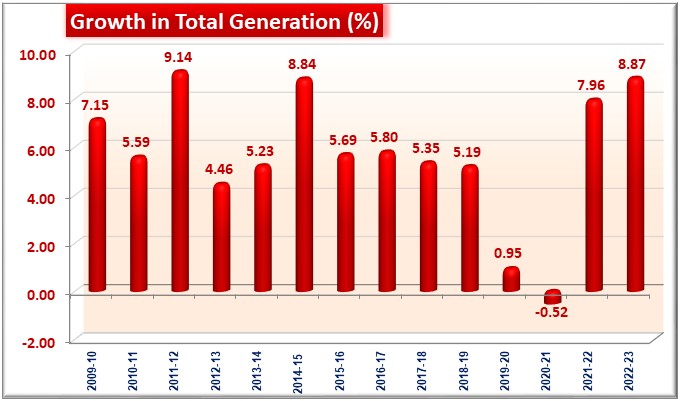
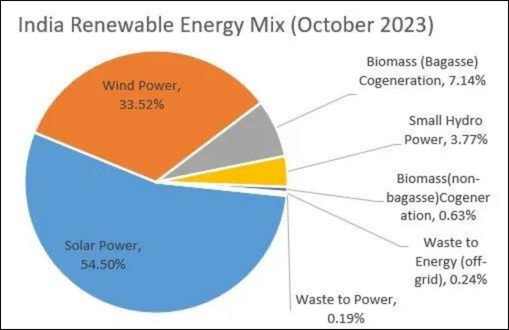
9.
Top five states with largest total power generations & Top five states with solar power generations?
| States | Total Power Generation(MUs) |
|---|---|
|
1.Maharashtra |
|
|
2.Chhattisgarh |
|
|
3.Uttar Pradesh |
|
|
4.Madhya Pradesh |
|
|
5.Gujarat |
|
Source:https://pib.gov.in/PressReleaseIframePage.aspx?PRID=1947380
Top 5 States in Solar power generation:-
| States | SOLAR POWER GENERATED IN 2022-23 (MU) |
|---|---|
|
1.Rajasthan |
|
|
2.Karnataka |
|
|
3.Gujarat |
|
|
4.Tamil Nadu |
|
|
5.Andhra Pradesh |
|
Source: https://pib.gov.in/PressReleasePage.aspx?PRID=1947140
According to the Ministry of New and Renewable Energy‟s website, solar power installed capacity in India has reached around 73.31 GW as of December 2023. Meanwhile, rooftop solar installed capacity is around 11.08 GW as of December 2023.
10.
How to calculate solar potential / how to fix direction and angle of solar panel?
Solar Potential
- The potential solar energy that can be harnessed by humans by using Photovoltaic systems for electricity generation or for solar water heating for a given location is termed as solar potential for that area.
- Solar potential again varies from place to place on Earth and depends on various factors such as sun angle, air mass, day length, cloud coverage, and pollution levels.
Process to estimate the solar potential
- Determine Solar Irradiance: Solar irradiance is the amount of solar power received per unit area at your location, usually measured in kilowatt-hours per square metre per day (kWh/m²/day). This data can be found through solar irradiance maps or databases specific to your region.
- Calculate Available Area: Measure the total area (in square metres) available for installing solar panels. This could be roof space, land area, or any suitable surface facing the sun.
- Factor in Panel Efficiency: Solar panel efficiency is the ratio of the energy output from the solar panel to the solar energy it receives. Modern solar panels typically have efficiencies ranging from 15% to 22%.
- Consider System Losses: System losses account for various inefficiencies in the solar power system, including inverter losses, temperature losses, and shading. These losses can reduce the effective output by about 14% to 23%.
- Estimate Solar Potential: Use the following formula to estimate the annual solar energy output (in kWh): Annual Solar Energy Output (kWh)=Solar Irradiance (kWh/m²/day)×Area (m²)×Efficiency×365 days×(1−System Losses).
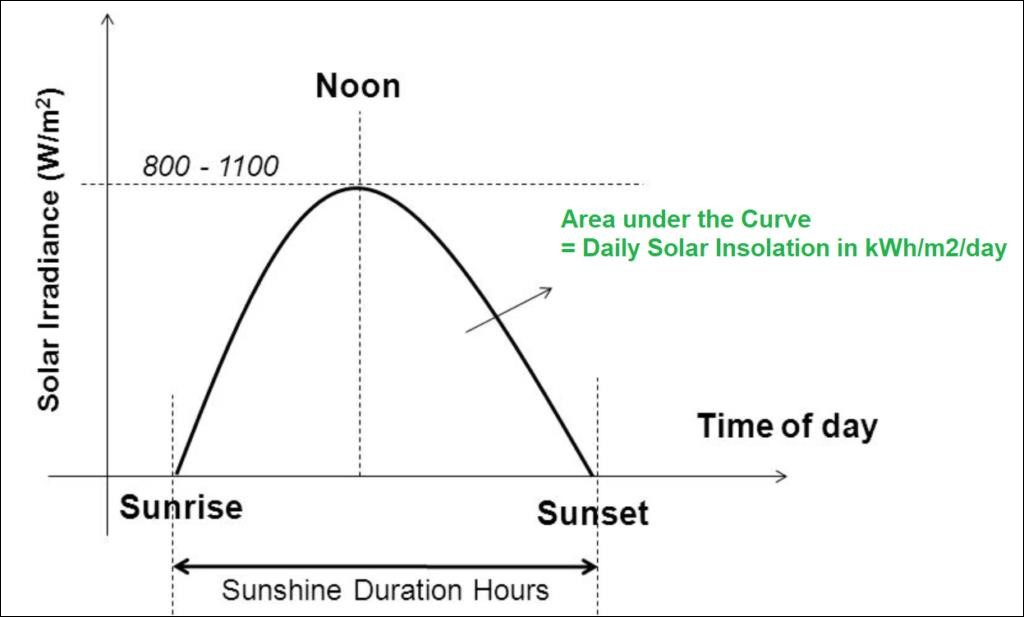
Optimum Solar Panel Angle
- To receive exceptional solar savings, solar panels need to be angled in a way that optimises the sunlight exposure for that location.
- This is done by tilting your solar panels at the same angle as the latitude of your home. For most homeowners, the ideal angle for a solar panel installation is close to or equal to the latitude of your home.
- This angle is typically between 30 degrees and 45 degrees. Doing so ensures your home will get the maximum average output from your solar power system throughout the year.
- Installing your panels at a steeper angle than your latitude (around 60 degrees) can help counteract winter production dips as snow can easily slide off.
11.
What is the One nation one grid concept?
- Grid management in the country, on a regional basis started in the sixties.
- At the beginning, state grids were interconnected to form a regional grid and India was demarcated into 5 regions namely Northern, Eastern, Western, North Eastern and Southern regions.
- With time each grid was connected to the other, to allow greater availability and transfer of power.
- On December 31, 2013, the Southern Region was connected to the Central Grid, completing 'One Nation, One Grid, One Frequency.
- It was implemented by Power Grid Corp. of India Ltd (PGCIL).
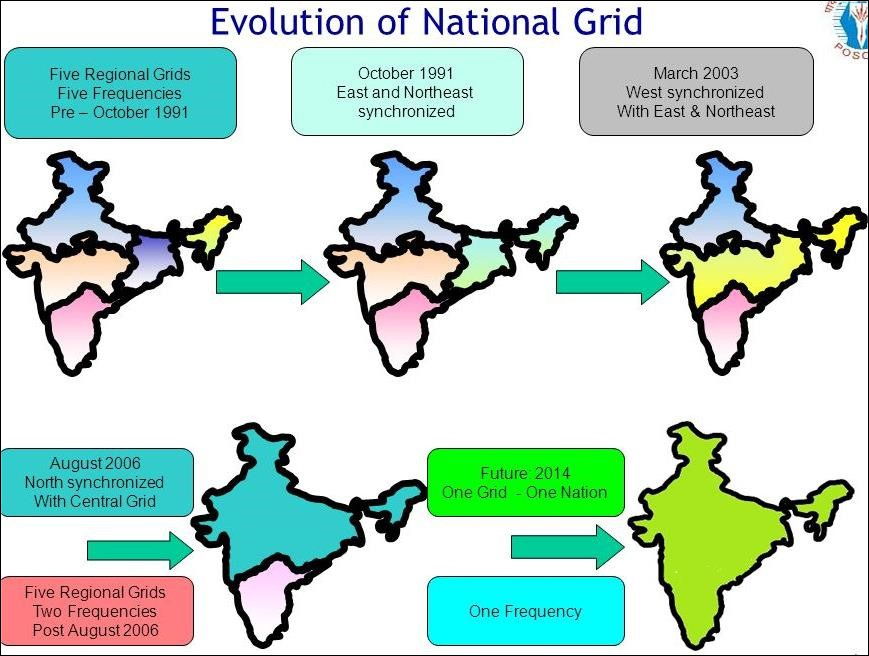
Advantages
- Synchronisation of all regional grids will help in optimal utilisation of scarce natural resources by transfer of Power from Resource centric regions to Load centric regions.
- One Nation One Grid shall synchronously connect all the regional grids and there will be one national frequency.
12.
What is India’s ranking in the world's top 5 Solar power generating countries?
India stands 4th in Solar Power capacity (as per REN21 Renewables 2022 Global Status Report).The installed solar energy capacity has increased by 30 times in the last 9 years and stands at 74.30 GW as of Jan 2024. India‟s solar energy potential is estimated to be 748 GWp as estimated by National Institute of Solar Energy (NISE).
India stands 5th in solar PV deployment across the globe at the end of 2022 (Ref. REN21‟s Global Status Report 2023 & IRENA‟s Renewable Capacity Statistics 2023).
13.
What are different types of solar panel Mounting Structures?
There are five primary types of solar mounting structures:-
RCC Roof Mounting Structure:
- These kinds of mounting structures are used to install solar panels over concrete rooftops.
- Roof-mounted racks reduce the distance between the solar array and the solar inverter.
- In doing so, it decreases the amount of wiring required, which prevents DC losses.
- These are the most common types of installations in the residential and commercial segments.
- Lower Installation Costs
- Easy to maintain
- Uses the unutilized roof space for energy generation
- Protects the roof underneath
- Requires roof penetration
- The roof should be shadow free and provide space for the correct orientation
- Difficult to scale up the system

Ground Mounting Structure:
Ground mounts place solar panels on the grounds of your property. This is an ideal solution if your roof lacks space for a roof mount or is excessively shadowed by trees.
- Allows for higher generation
- Can accommodate higher capacity
- No house modifications are required
- Easier to install tracking systems
- High cost of installations
- Requires shadow-free land space
- Susceptible to vandalism and accumulation of dirt under panels

Carport Mounting Structure:
- Carport structures are very similar to ground-mounted solar structures.
- The only major difference is that unlike the latter, carports are installed at a considerable height to allow car parking space underneath.
- It is also easy to integrate these types of solar plants with in-built electric vehicle (EV) charging stations.
- Easy to Maintain
- Utilises underused spaces for energy generation
- Provides dual function of energy generation and providing shade.
- Easier to install tracking systems
- Requires shadow-free land space for set up
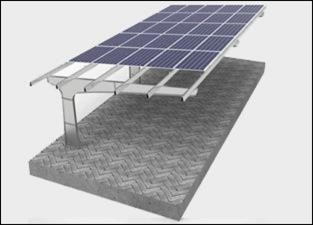
Shed Mounting Structures:
- Shed Mounting structures are essentially rooftop solar structures.
- However, rather than concrete roofs, they are mounted on metal sheds/sheet roofing.
- These can be used in the residential sector, but are more popular among commercial and industrial consumers.
- Low Installation Cost
- Easy to maintain
- Turns the unused roof space into an energy generation spot
- Average power output
- Requires shadow-free roof space to set up panels
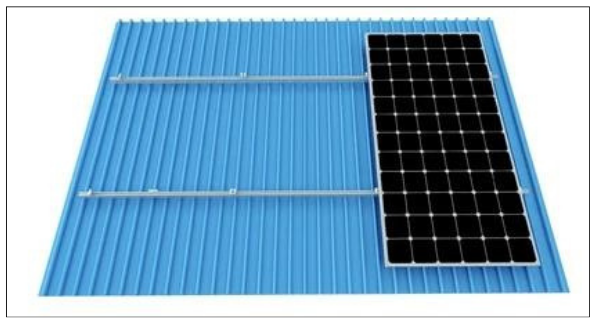
Tracking System Mounting Structures:
- Tracking System Mounted Racks are used for solar tracking and solar water pumping systems.
- Solar trackers are automatic devices that allow your panels to follow the direction of the sun throughout the day for the best solar exposure. They are very beneficial in hot regions.
- Maximises generation during peak hours
- Can optimise the potential of limited space
- Avoids shading to raise efficiency
- High cost of installation
- Complex installation process
- Difficult to maintain
14.
What other devices / equipment is required in solar power setup apart from solar panels such as inverters, batteries, transformers, transmission line etc?
In a solar power setup, several key components are necessary to ensure efficient energy conversion, storage, and distribution. Apart from solar panels, essential devices and equipment include:
1. Inverters: Convert the direct current (DC) generated by the solar panels into alternating current (AC), which is used by household appliances and for feeding electricity back into the grid. Inverters are central to the functionality of a solar power system.
2. Batteries: Store excess electricity generated during the day for use during the night or when solar generation is low. This component is crucial for off-grid systems and for grid-tied systems with energy storage to enhance energy independence and provide backup power.
3. Charge Controllers: Regulate the rate at which electric current is added to or drawn from electric batteries, preventing overcharging, over-discharging, and prolonging battery life. They are essential in systems where batteries are used for energy storage.
4. Mounting Systems: Provide the structural support to fix solar panels in the optimal position. They can be installed on rooftops, on the ground, or as tracking systems that follow the sun to maximise solar exposure.
5. Wiring and Electrical Connectors: Facilitate the flow of electric current between the solar panels, inverter, the grid, and any storage devices. Proper wiring and connectors are essential for safety and system efficiency.
6. Transformers: If the system is designed to supply power to the grid or operate with appliances running on a different voltage, transformers adjust the voltage to the appropriate level.
7. Transmission Lines: In larger solar installations, especially in solar farms, transmission lines carry the generated electricity from the site of production to the grid or the point of use.
8. Protection Equipment: Includes fuses, circuit breakers, and surge protectors to protect the solar power system from electrical faults and lightning strikes.
9. Energy Management System: For more sophisticated systems, especially those integrated with the grid or with dynamic pricing, an energy management system can optimise when to store energy, when to use it directly, and when to sell it back to the grid.
10. Monitoring Systems: Allow for the real-time tracking of energy production and usage. These systems can help identify any issues or inefficiencies in the solar array and ensure the system operates at optimal capacity.
15.
What is the net metering concept in household solar installation?
Net metering is a billing mechanism that credits solar energy system owners for the electricity they add to the grid.
For example, if a residential customer has a PV system on their roof, it may generate more electricity than the home uses during daylight hours. If the home is net-metered, the electricity metre will run backwards to provide a credit against what electricity is consumed at night or other periods when the home's electricity use exceeds the system's output. Customers are only billed for their "net" energy use. On average, only 20-40% of a solar energy system‟s output ever goes into the grid, and this exported solar electricity serves nearby customers‟ loads.
16.
Other related information as found suitable:-
Why should a household opt for the RoofTop Solar Scheme?
- The households will be able to save electricity bills as well as earn additional income through sale of surplus power to DISCOMs.
- PM Surya Ghar Muft Bijlee Yojana promises an assured saving of approximately Rs 15,000 in a year for a household consuming up to 300 units a month, by installing RoofTop Solar unit of 3 kW capacity.
- Such a household, by generating its own electricity will save on electricity bill approximately Rs 1,800 – Rs 1875.
- Even after deducting the EMI of Rs 610 on the loan availed for financing the solar unit, the saving would be around Rs 1,265 per month or approximately Rs 15,000 in a year.
- The savings for the households not availing of loan will be even higher.
- Furthermore, by opting for renewable energy, it is an opportunity to contribute towards a greener planet.
What are “Freebies” often mentioned in the news ?
- Reserve Bank of India in its report in 2022, has defined freebies as “a public welfare measure that is provided free of charge”.
- It adds that freebies are different from public/merit goods such as health and education, expenditure on which has wider and long-term benefits.
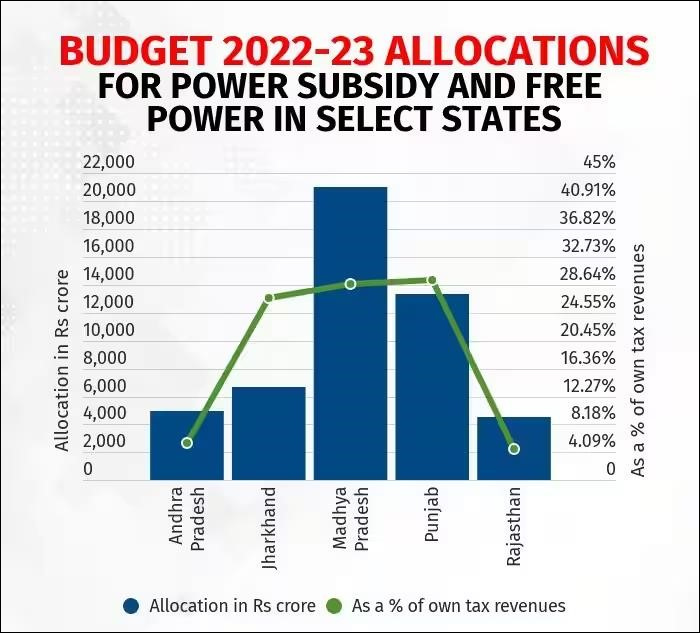
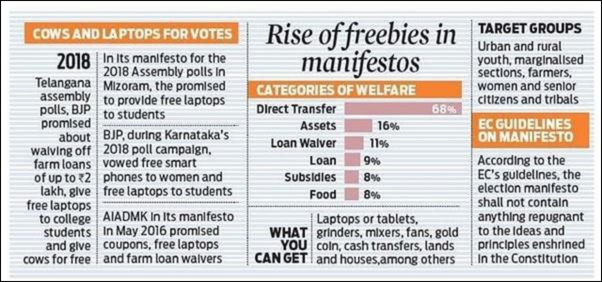
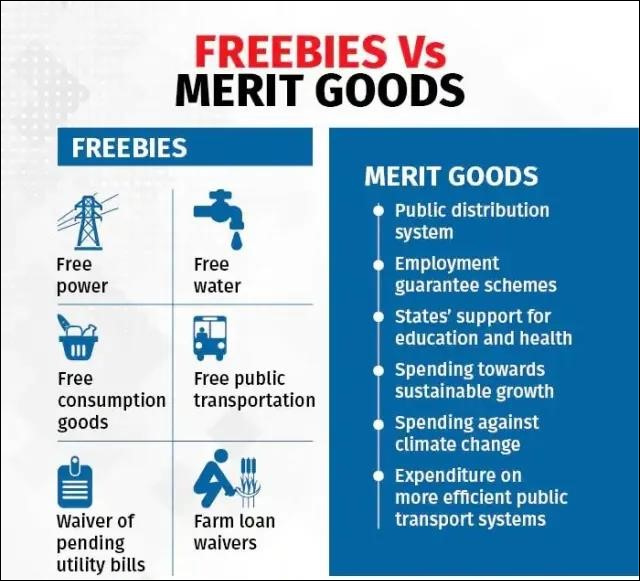
Challenges faced due to freebies:
Financial irregularity:
- The reckless spending of the taxpayers money on freebies is neither a recognised policy/custom nor it is sanctioned in a court of law.
- It is blatant financial irregularity that amounts to bribing voters using public money solely for gaining advantage in electoral politics.
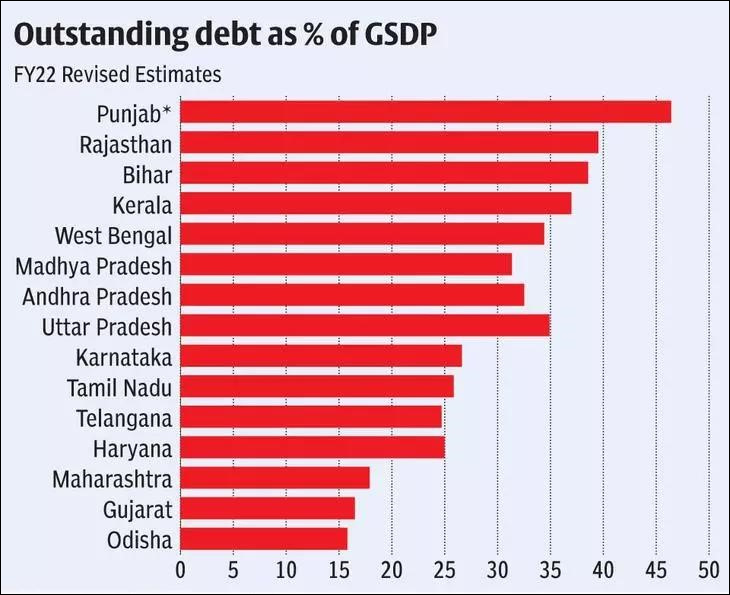
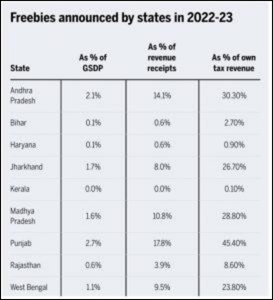
Burden on Public Exchequer:
- If states continue with fiscal profligacy, they will be heading towards unsustainable high debt with catastrophic consequences for macroeconomic stability and ability of India to sustain high growth. Ex Farm Loan waiver.
Vote bank politics:
- Political parties‟ promises to lure voters in their favour is analogous to bribery and undue influences.
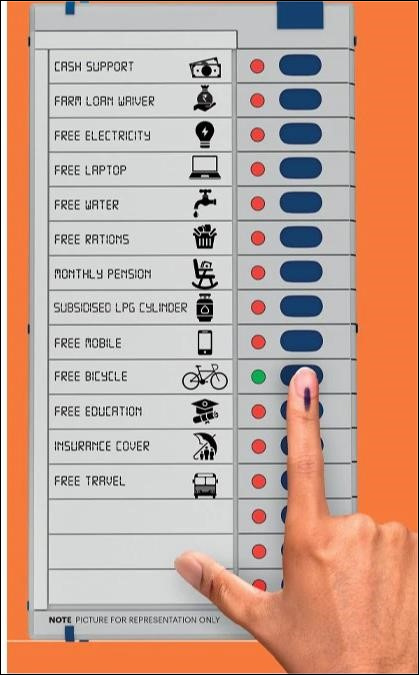
Lacking equity or fairness:
- Freebies serve even those who are capable of managing on their own at the cost of those who can not pay for their own.
- This promotes inequality. Ex fixes monthly cash transfer to all women in Punjab and Karnataka.
Fiscal mismanagement:
- Most states lack the cushion to spend money as freebies and then be able to save the state's finances from going down into fiscal deficits.
Promotes tax avoidance:
- Freebies may even trigger non-compliance amongst taxpayers and eventually lead to lower revenue.
Supreme court view on freebies:
- The SC acknowledged that the impact of freebies promised by political parties on the country‟s fiscal health was “a serious issue”. But derecognising political parties that resort to freebies would be “anti-democratic”. The Supreme court said „freebies‟ are different from the welfare schemes of the government
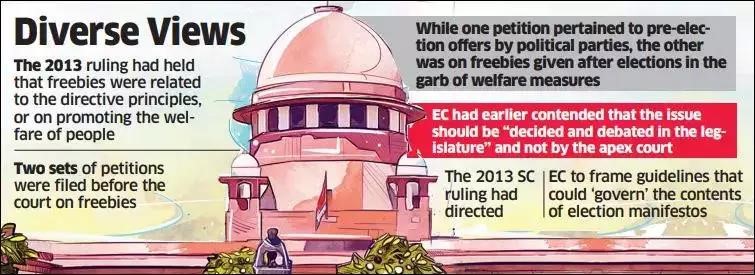
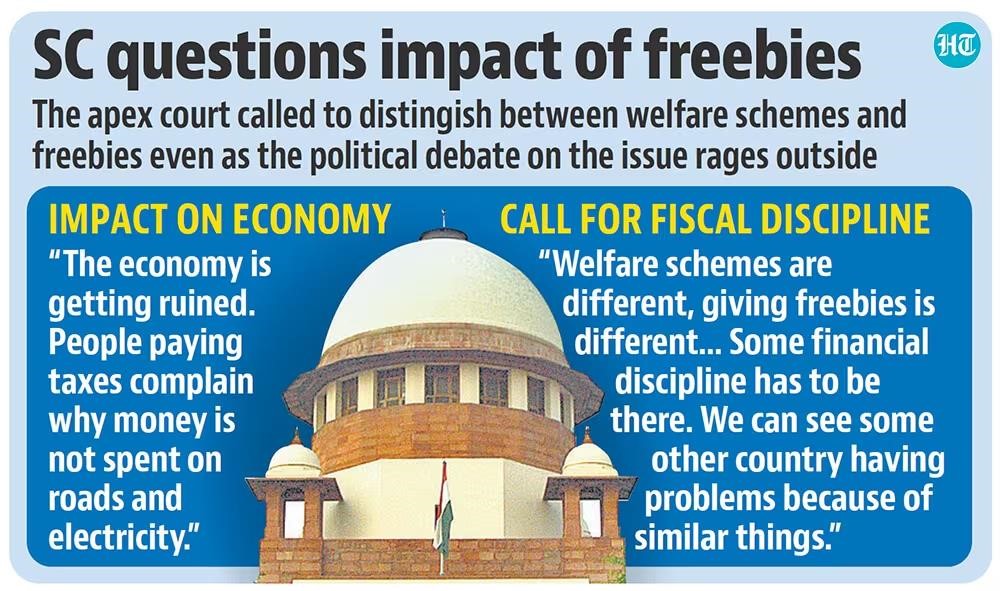
Earlier supreme court in S. Subramaniam Balaji versus Tamil Nadu case 2013 held that making promises in election manifestos do not amount to a „corrupt practice‟ under Section 123 of the Representation of People Act.
RBI view on freebies:

Election commission of India view on freebies:
- The Election Commission wants parties to disclose the cost of „revdi‟, and how it will be funded.
- ECI plans propose that political parties should detail the cost of promises made ahead of Assembly or national polls and also juxtapose the state of their finances giving voters some idea about how these could be financed.
- While political parties can‟t be stopped from making promises, the voter too has a right to be informed to make an informed choice.
HONOURABLE PM MODI’s views on freebies:
- Prime Minister Narendra Modi had recently cautioned people against the "revadi culture" or distribution of freebies to get votes, taking a dig at the poll promises made by opposition parties, offering free facilities to the people.
Some UPSC Prelims Previous Years Questions
Q1. With reference to coal-based thermal power plants in India, consider the following statements: (2023)
1. None of them uses seawater.
2. None of them are set up in water-stressed districts.
3. None of them is privately owned
How many of the above statements are correct?
(a) Only one
(b) Only two
(c) All three
(d) None
Q2. Consider the following statements: (2022)
1. Gujarat has the largest solar park in India.
2. Kerala has a fully solar powered International Airport
3. Goa has the largest floating solar photovoltaic project in India.
Which of the statements given above is/are correct?
(a) 1 and 2
(b) 2 only
(c) 1 and 3
(d) 3 only
Q3. With reference to solar water pumps, consider the following statements: (2020)
1. Solar power can be used for running surface pumps and not for submersible Pumps.
2. Solar power can be used for running centrifugal pumps and not the ones with piston.
Which of the statements given above is/are correct?
(a) 1 only
(b) 2 only
(c) Both 1 and 2
(d) Neither 1 nor 2
Some UPSC Mains Previous Years Questions
Q1. Do you think India will meet 50 percent of its energy needs from renewable energy by 2030? Justify your answer. How will the shift of subsidies from fossil fuels to renewables help achieve the above objective? Explain. (2022)
Q2. Describe the benefits of deriving electric energy from sunlight in contrast to conventional energy generation. What are the initiatives offered by our Government for this purpose? (2020)
Some Questions from this Year and Previous Years Interview Transcripts
Board BB Swain sir:
- Tell me what was today's news about the solar rooftop program?
- Why is it a free electricity scheme?
- Are you aware about the additional weight the solar rooftop would put on the building and do old houses, especially dilapidated buildings have capacity to bear that weight?
- Solar energy related again long narration but the gist was that can Tech help in CC?
Board Gen Raj Shukla sir:
- Long monologue on ongoing infrastructure development in India. From where will we get energy for these projects? Can we go for more greener alternatives?
- Problems in Nuclear energy growth?
- Challenges in solar energy growth?
- Import dependency on China for Solar modules, we can make them here.
- Why are we importing from China?
- Status of Rajasthan in solar capacity?
- Question is not on Installed capacity but potential capacity?
Board Dinesh Dasa sir:
- Intermittency & Variability in solar energy? Steps to address it?
- Steps for increasing energy capacity?
- What initiatives have we brought in the renewable energy sector?
- What is the status of solar energy in the country?
- Solar Power plant in MP, anything special about the Rewa power plant?
Board Suman Sharma mam:
- What are we doing for solar rooftop?